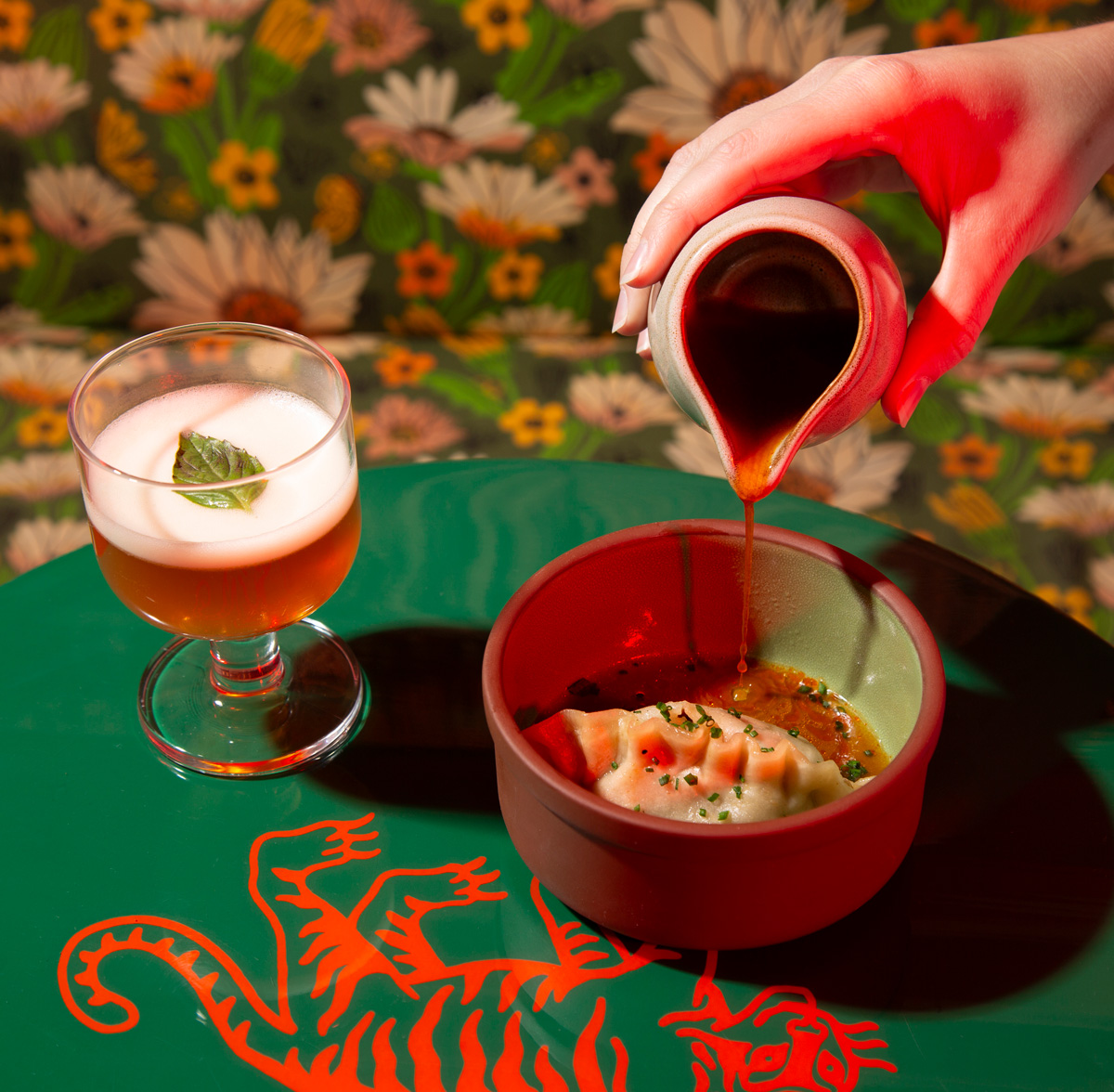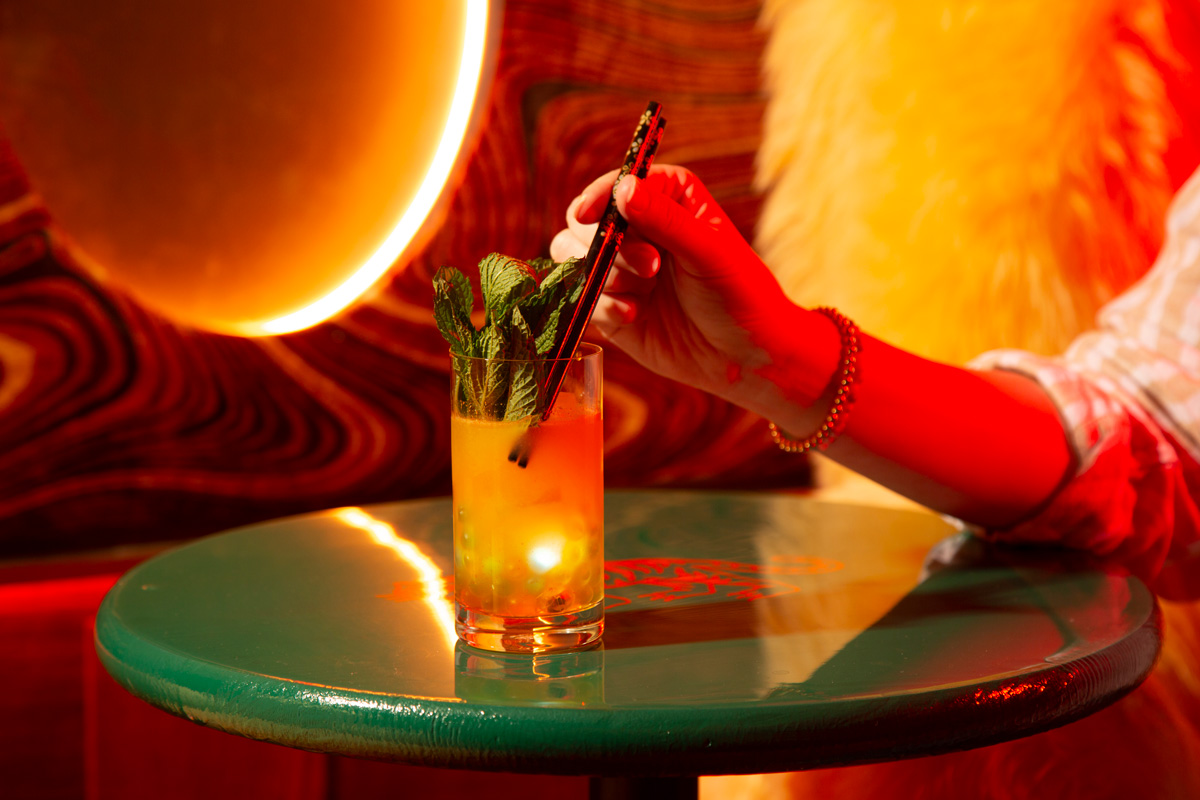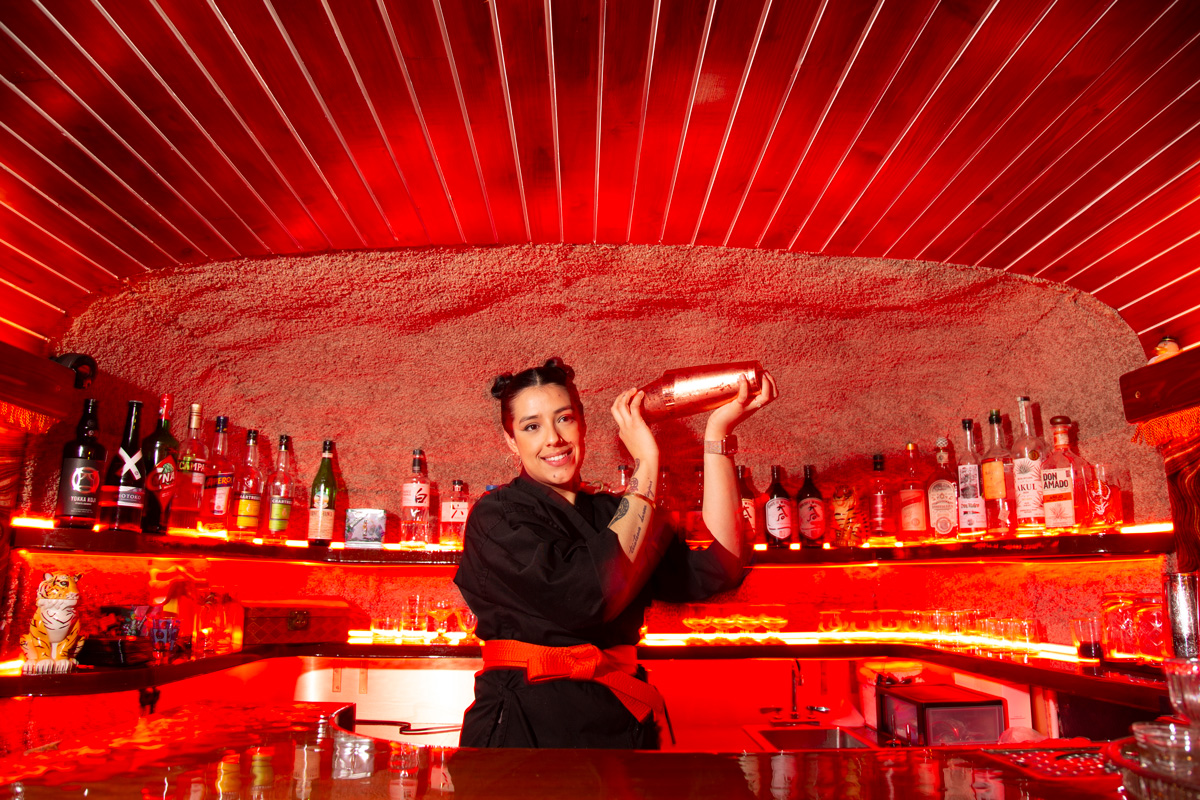
Photograph by Martha Williams
People who live in Atlanta and consume related social media know the phrase “Atlanta is not a real place.” For the uninitiated, it’s an umbrella slogan that refers to the magnetic but disorienting energy here—an unpredictability unique to us. That’s the feeling you get when you step into Tiger Sun, a converted bus turned omakase-style cocktail bar behind Muchacho on the Beltline.
Tiger Sun is one of Atlanta’s toughest reservations to secure, but it’s not due to exclusivity. With 18 seats on the refurbished vintage tour bus and only two seatings from Wednesday to Sunday, the bar is one of the most coveted spots in Atlanta. Reservations are made during biweekly drops, and they go so fast that receiving a confirmation for the cocktail omakase can feel like winning a medal. (If you miss out, don’t stress. I’ve grabbed last-minute cancellations easily on Resy.)
Tiger Sun offers something unexpected in a city known for its creative spirit. It’s not just another bar or restaurant; it’s an immersive cocktail and dining happening that pushes the boundaries of what I have come to expect from a night out in Atlanta.

Photograph by Martha Williams
Each season reveals a new theme. At the time of this writing, it’s Karate Kid. I enter Tiger Sun’s “dojo,” which draws martial arts inspiration from the 1980s film. The bus is fully committed to the motif: A Bruce Lee poster, a large tiger head, furry sheepskin seats, and music by The Who all add to the setting, creating a surreal world—one where anything can happen just steps from Memorial Drive. There’s even orange shag carpet and windows converted to neon lights that glow red and orange. The lights cycle through other colors when the servers ask you to take a “caviar bump” with them—for an additional fee. “When the lights go down, the vibes go up,” says one of the hosts as she turns down the lights.
The vibes are vibing at Tiger Sun, and I feel transported on the moody bus, which is an approximation of the bus I imagine when listening to Frankie Smith’s 1981 bop, the “Double Dutch Bus.” The bus rocks when the all-female staff shakes cocktails to order or when someone steps on with a platter of courses from the nearby Muchacho kitchen.
Joe Schafer, Electric Hospitality’s vice president of culinary operations and formerly of Bacchanalia, oversees food pairings, and Ranger Station’s McKenzie Nelson brings her award-winning mixology skills. The duo’s collaboration is a win-win as plates and beverages all seem carefully crafted to complement one another.

Photograph by Martha Williams
Each table gets two different menus with four rounds of dishes and cocktails with names inspired by the movie. This means each person’s experience is distinct, but tables can always share sips and bites. Keeping with the Karate Kid theme, this season’s menus are “Wax On” and “Wax Off.” There are even joke menu items such as “Private lessons at the Tree of Life Dojo”—market price, of course. One criticism is that there is little room for dietary restrictions, per the website, so this is not the place for those with such concerns.
The food is exceptionally executed overall, with some minor mistakes I noted over two visits. My favorite dish was the birria potsticker, filled with pulled beef birria. The hot broth is poured over the monster dumpling, adding an element of theater to the meal and enhancing the deep, savory flavors.
The birria contrasts with the boozy Sweep the Leg, a mix of mezcal, ponzu, Thai basil, barley, shochu, lime, and orange shrub. Drink creations push the boundaries of what one would expect, and pack so much flavor in tiny glasses. Cream cheese–washed gin paired with mezcal in the Fish and Karate also gets a playful pop from cucumber vermouth. It arrives with a sweet crab bite on top of a fried rectangle of crispy rice that was a little greasy.
Some drinks go even further, providing a visual wow, like cocktails that light up, casting an ethereal glow as they hit the table. One illuminated cocktail, the Beginner’s Luck, arrives with chopsticks so you can fish for boba, which is meant to pay homage to the scene in which the film’s main character, Daniel, struggles to catch a fly with chopsticks.

Photograph by Martha Williams
The gochujang and green Chartreuse-infused drink is incredibly strong, but appropriately so, as it comes with slightly oversalted but crispy fried chicken. Tiger Sun’s answer to a French 75, the Banzai, is made with plum wine, green Sichuan vodka, lychee, gin, and yuzu. It’s effervescent on the tongue and delightfully topped with a cloud of vanilla cotton candy. It was illuminated by a tiny light immersed in the base of the Nick and Nora glass.
I went twice to experience both menus, and Tiger Sun was a fun addition to my predictable routine. I recommend this singular omakase immersion to any cocktail-loving Atlantan who is looking for something different and wants to chill in close quarters with new friends. While a night at Tiger Sun is $75 per person, the price is more than fair when you consider how much you get during the four-course tasting menu. I thought I’d be ready for a second round of food—or what I call a “Hobbit meal” (since Hobbits eat up to seven meals a day), but I was satiated after my final bite of a crumbly shortbread topped with crispy pork cracklings.
Everything here is crafted with intention. Tiger Sun isn’t the beginning of a night out. This is the night out. Still, hungrier guests can opt for “extra kicks”—themed additions that let you personalize your indulgence further—such as caviar bumps and assorted yakitori skewers of char-gilled Wagyu beef and maitake mushrooms. There is also a long list of spirits, filed under “Trophy Ceremony” on the menu, if you want more booze. But the evening’s sips are so strong that a ride-share service is recommended.
What’s cool about Tiger Sun is that it will continue to change with rotating themes (next up: Pulp Fiction), which means you can go once every season for a different menu. In a city like Atlanta, where the strange and unique are celebrated, Tiger Sun is a reminder that even in a surreal town, there’s still room for innovation and a little escape.
This article appears in our June 2025 issue.
Advertisement




